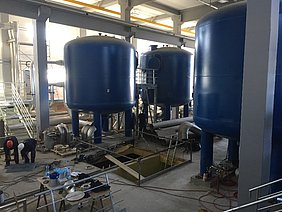Ceramic membranes were applied to produce lime water with low amounts of residuals under real waterworks conditions. This was demonstrated on a pilot scale with a direct link to the full scale plant.
Lime water is often produced in waterworks using lime saturators. First a milk of lime suspension is produced from supplied lime (e.g. calcium hydroxide) and raw water. Raw water is added to the milk of lime. To dissolve the calcium hydroxide and sediment out the insoluble lime components, the mixture is placed in a lime saturator, a high-volume cylindrical tank. The saturators have slow reaction times and sometimes produce lime water of varying quality. However, a particular disadvantage is the accumulation of residues.
As part of a project funded by the innovation fund for climate and water protection of badenova AG & Co. KG, a method was designed to produce lime water based on membrane technology and this was used in a pilot study that was closely linked to industrial technology.
The method included the use of a special ceramic membrane. In combination with preliminary treatment of the dissolving water it was possible to reduce the accumulation of sludge by more than 80 % compared with previous results in large-scale operation. No waste water was generated. The lime water is particle-free and its quality is consistent. Lime water production can easily be automated and can be quickly adapted to varying drinking water production quantities. The plant has compact dimensions and a small footprint.
In principle, the method trialled on a pilot scale appears to be usable under waterworks conditions, thereby presenting a new option for future-oriented water treatment.
Publications
Müller, U.; Rhode, K.: Rückstandsminimierte Kalkwasserherstellung im Wasserwerk mittels Membrankreislaufverfahren [Limewater production in waterworks by a closed-loop membrane process]. gwf Wasser Abwasser April 2017, 47 - 56

![[Translate to English:] Prüfstelle-Produktprüfung_Teststand Test centre and product testing](/fileadmin/_processed_/0/9/csm_TZW-Karlsruhe_Pruefung_Geraete-Teststand_377188946c.jpg)
























